[转]Code! MVC 5 App with Facebook, Twitter, LinkedIn and Google OAuth2 Sign-on (C#)
This tutorial shows you how to build an ASP.NET MVC 5 web application that enables users to log in using OAuth 2.0 with credentials from an external authentication provider, such as Facebook, Twitter, LinkedIn, Microsoft, or Google. For simplicity, this tutorial focuses on working with credentials from Facebook and Google.
Enabling these credentials in your web sites provides a significant advantage because millions of users already have accounts with these external providers. These users may be more inclined to sign up for your site if they do not have to create and remember a new set of credentials.
See also ASP.NET MVC 5 app with SMS and email Two-Factor Authentication.
The tutorial also shows how to add profile data for the user, and how to use the Membership API to add roles. This tutorial was written by Rick Anderson ( Please follow me on Twitter: @RickAndMSFT ).
- Getting Started
- Creating Your First Application
- Setting up SSL in the Project
- Creating a Google app for OAuth 2 and connecting the app to the project
- Creating the app in Facebook and connecting the app to the project
- Examine the Membership Data
- Adding Profile Data to the User Class
- Logging off your App and Logging in With Another Account
Getting Started
Start by installing and running Visual Studio Express 2013 for Web or Visual Studio 2013. Install Visual Studio 2013 Update 3 or higher. For help with Dropbox, GitHub, Linkedin, Instagram, buffer, salesforce, STEAM, Stack Exchange, Tripit, twitch, Twitter, Yahoo and more, see this one stop guide.
Click New Project from the Start page, or you can use the menu and select File, and then New Project.
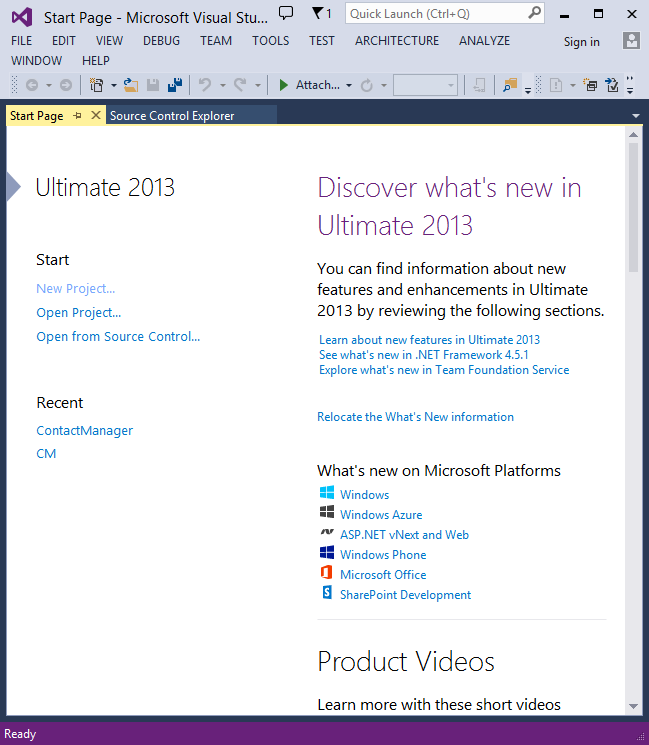
Creating Your First Application
Click New Project, then select Visual C# on the left, then Web and then select ASP.NET Web Application. Name your project "MvcAuth" and then click OK.

In the New ASP.NET Project dialog, click MVC. If the Authentication is not Individual User Accounts, click the Change Authenticationbutton and select Individual User Accounts. By checking Host in the cloud, the app will be very easy to host in Azure.
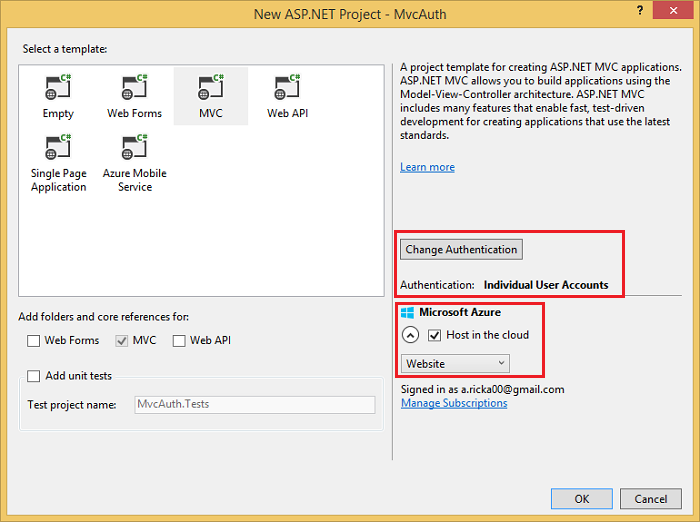
If you selected Host in the cloud, complete the configure dialog.

Use NuGet to update to the latest OWIN middleware
Use the NuGet package manager to update the OWIN middleware. Select Updates in the left menu. You can click on the Update All button or you can search for only OWIN packages (shown in the next image):

In the image below, only OWIN packages are shown:
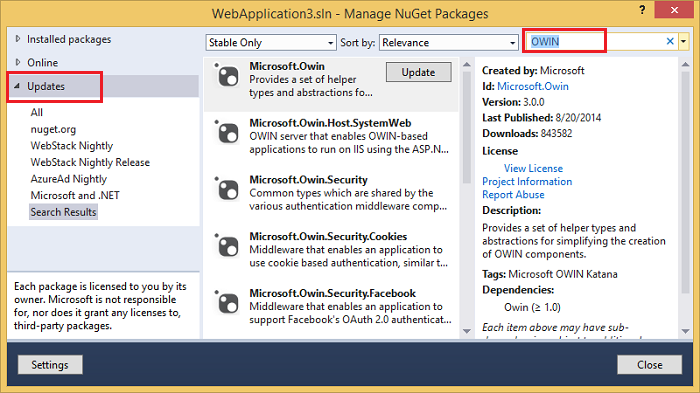
From the Package Manager Console (PMC), you can enter the Update-Package command, which will update all packages.
Press F5 or Ctrl+F5 to run the application. In the image below, the port number is 1234. When you run the application, you'll see a different port number.
Depending on the size of your browser window, you might need to click the navigation icon to see the Home, About, Contact, Register andLog in links.


Setting up SSL in the Project
To connect to authentication providers like Google and Facebook, you will need to set up IIS-Express to use SSL. It's important to keep using SSL after login and not drop back to HTTP, your login cookie is just as secret as your username and password, and without using SSL you’re sending it in clear-text across the wire. Besides, you’ve already taken the time to perform the handshake and secure the channel (which is the bulk of what makes HTTPS slower than HTTP) before the MVC pipeline is run, so redirecting back to HTTP after you’re logged in won’t make the current request or future requests much faster.
- In Solution Explorer, click the MvcAuth project.
- Hit the F4 key to show the project properties. Alternatively, from the View menu you can select Properties Window.
- Change SSL Enabled to True.
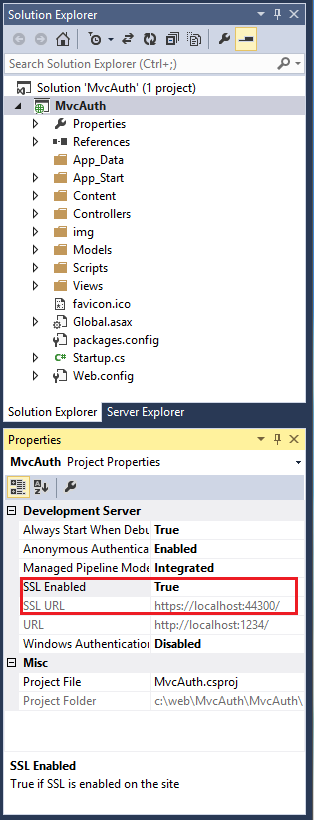
- Copy the SSL URL (which will be https://localhost:44300/ unless you've created other SSL projects).
- In Solution Explorer, right click the MvcAuth project and select Properties.
- Select the Web tab, and then paste the SSL URL into the Project Url box. Save the file (Ctl+S). You will need this URL to configure Facebook and Google authentication apps.

- Add the RequireHttps attribute to the
Homecontroller to require all requests must use HTTPS. A more secure approach is to add the RequireHttps filter to the application. See the section "Protect the Application with SSL and the Authorize Attribute" in my tutoral Create an ASP.NET MVC app with auth and SQL DB and deploy to Azure App Service. A portion of the Home controller is shown below.[RequireHttps]
public class HomeController : Controller
{
public ActionResult Index()
{
return View();
} - Press CTRL+F5 to run the application. If you've installed the certificate in the past, you can skip the rest of this section and jump toCreating a Google app for OAuth 2 and connecting the app to the project, otherwise, follow the instructions to trust the self-signed certificate that IIS Express has generated.

- Read the Security Warning dialog and then click Yes if you want to install the certificate representing localhost.
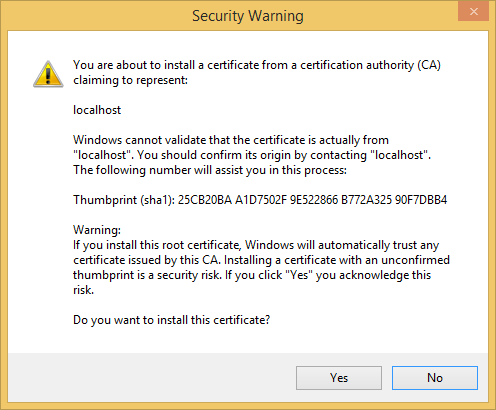
- IE shows the Home page and there are no SSL warnings.

- Google Chrome also accepts the certificate and will show HTTPS content without a warning. Firefox uses its own certificate store, so it will display a warning. For our application you can safely click I Understand the Risks.
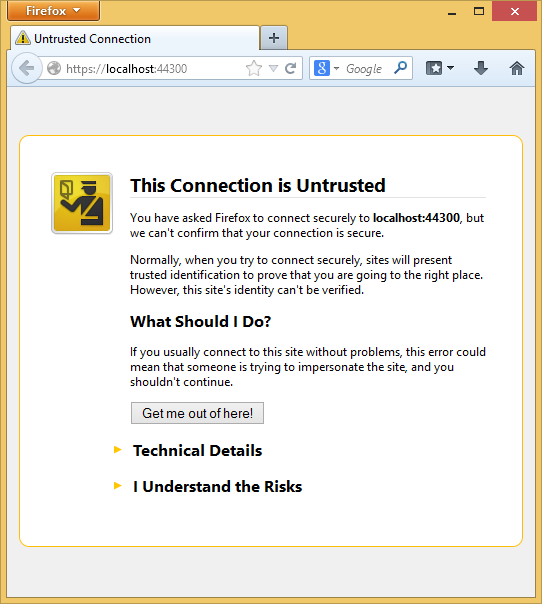
Creating a Google app for OAuth 2 and connecting the app to the project
- Navigate to the Google Developers Console.
- Click the Create Project button and enter a project name and ID (you can use the default values). In a few seconds the new project will be created and your browser will display the new projects page.
- In the left tab, click APIs & auth, and then > Credentials.
- Click the Create New Client ID under OAuth.
- In the Create Client ID dialog, keep the default Web application for the application type.
- Set the Authorized JavaScript origins to the SSL URL you used above (https://localhost:44300/ unless you've created other SSL projects)
- Set the Authorized redirect URI to:
https://localhost:44300/signin-google
- Click the Consent screen menu item, then set your email address and product name. When you have completed the form click Save.
- Click the APIs menu item, scroll down and click the off button on Google+ API.
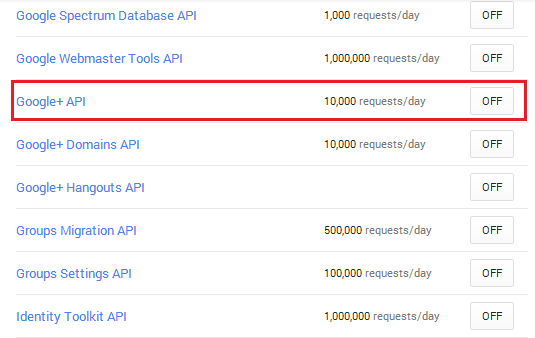
The image below shows the enabled APIs.

Copy and paste the AppId and App Secret into the
UseGoogleAuthenticationmethod. The AppId and App Secret values shown below are samples and will not work.public void ConfigureAuth(IAppBuilder app)
{
// Configure the db context and user manager to use a single instance per request
app.CreatePerOwinContext(ApplicationDbContext.Create);
app.CreatePerOwinContext<ApplicationUserManager>(ApplicationUserManager.Create); // Enable the application to use a cookie to store information for the signed in user
// and to use a cookie to temporarily store information about a user logging in with a third party login provider
// Configure the sign in cookie
app.UseCookieAuthentication(new CookieAuthenticationOptions
{
AuthenticationType = DefaultAuthenticationTypes.ApplicationCookie,
LoginPath = new PathString("/Account/Login"),
Provider = new CookieAuthenticationProvider
{
OnValidateIdentity = SecurityStampValidator.OnValidateIdentity<ApplicationUserManager, ApplicationUser>(
validateInterval: TimeSpan.FromMinutes(30),
regenerateIdentity: (manager, user) => user.GenerateUserIdentityAsync(manager))
}
}); app.UseExternalSignInCookie(DefaultAuthenticationTypes.ExternalCookie); // Uncomment the following lines to enable logging in with third party login providers
//app.UseMicrosoftAccountAuthentication(
// clientId: "",
// clientSecret: ""); //app.UseTwitterAuthentication(
// consumerKey: "",
// consumerSecret: ""); //app.UseFacebookAuthentication(
// appId: "",
// appSecret: ""); app.UseGoogleAuthentication(
clientId: "000-000.apps.googleusercontent.com",
clientSecret: "00000000000");
}
Press CTRL+F5 to build and run the application. Click the Log in link.

Under Use another service to log in, click Google.
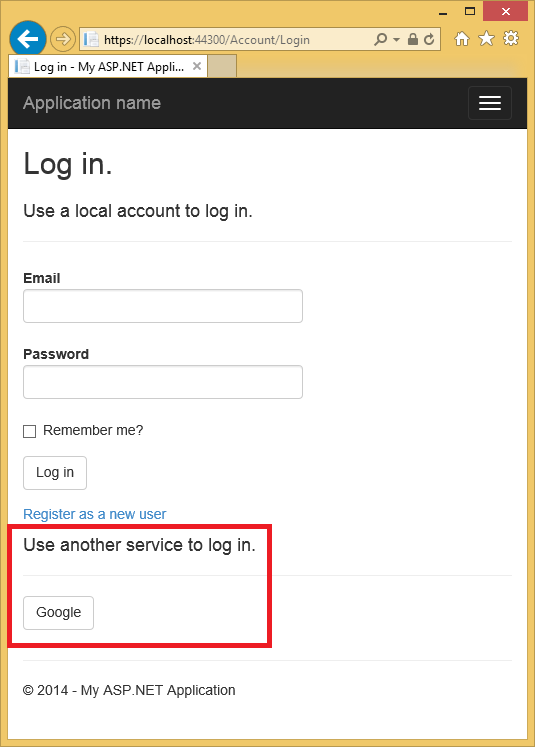 Note: If you miss any of the steps above you will get a HTTP 401 error. Recheck your steps above. If you miss a required setting (for example product name), add the missing item and save, it can take a few minutes for authentication to work.
Note: If you miss any of the steps above you will get a HTTP 401 error. Recheck your steps above. If you miss a required setting (for example product name), add the missing item and save, it can take a few minutes for authentication to work.You will be redirected to the google site where you will enter your credentials.
aaarticlea/gif;base64,R0lGODlhAQABAIAAAP///wAAACwAAAAAAQABAAACAkQBADs=" alt="" width="535" height="747" data-original="https://media-www-asp.azureedge.net/media/4865360/z3.png" />
After you enter your credentials, you will be prompted to give permissions to the web application you just created:
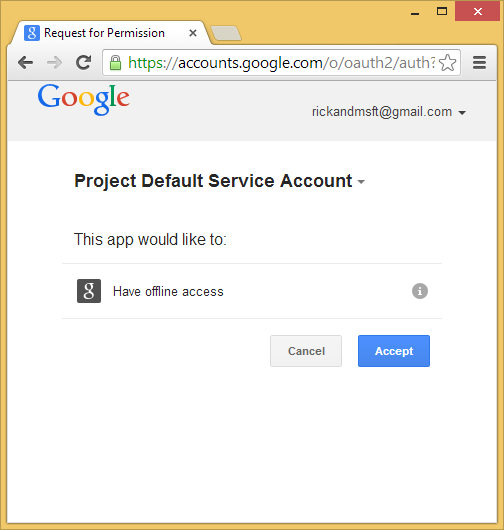
Click Accept. You will now be redirected back to the Register page of the MvcAuth application where you can register your Google account. You have the option of changing the local email registration name used for your Gmail account, but you generally want to keep the default email alias (that is, the one you used for authentication). Click Register.
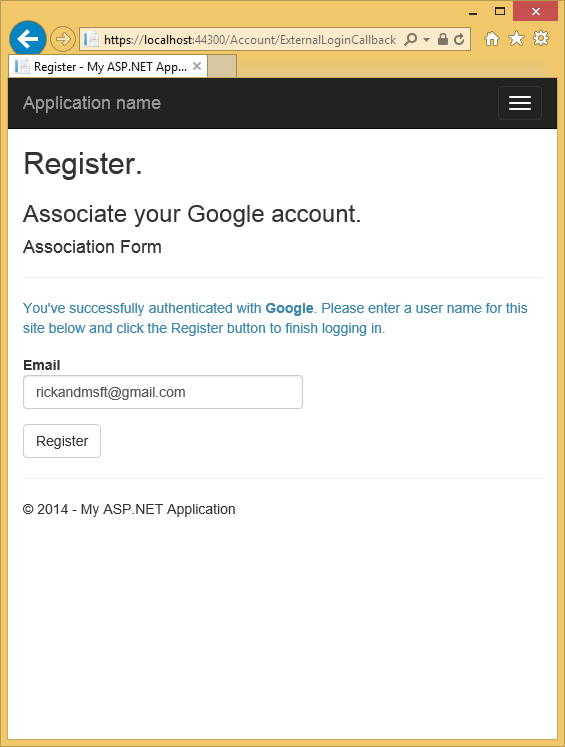
Creating the app in Facebook and connecting the app to the project
For Facebook OAuth2 authentication, you need to copy to your project some settings from an application that you create in Facebook.
In your browser, navigate to https://developers.facebook.com/apps and log in by entering your Facebook credentials.
If you aren’t already registered as a Facebook developer, click Register as a Developer and follow the directions to register.
On the Apps tab, click Create New App.
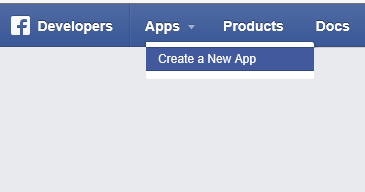
Enter an App Name and Category, then click Create App.
This must be unique across Facebook. The App Namespace is the part of the URL that your App will use to access the Facebook application for authentication (for example, https://apps.facebook.com/{App Namespace}). If you don't specify an App Namespace, theApp ID will be used for the URL. The App ID is a long system-generated number that you will see in the next step.
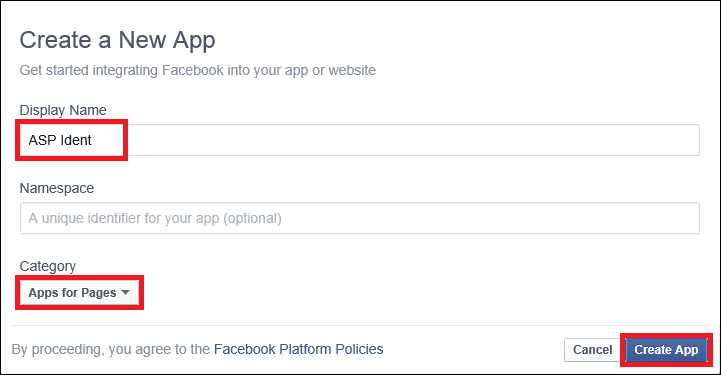
Submit the standard security check.
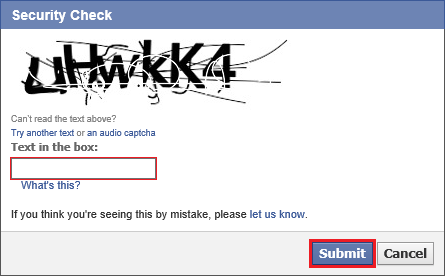
Select Settings for the left menu bar.
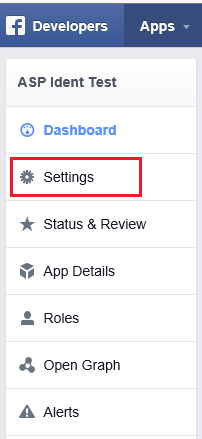
On the Basic settings section of the page select Add Platform to specify that you are adding a website application.
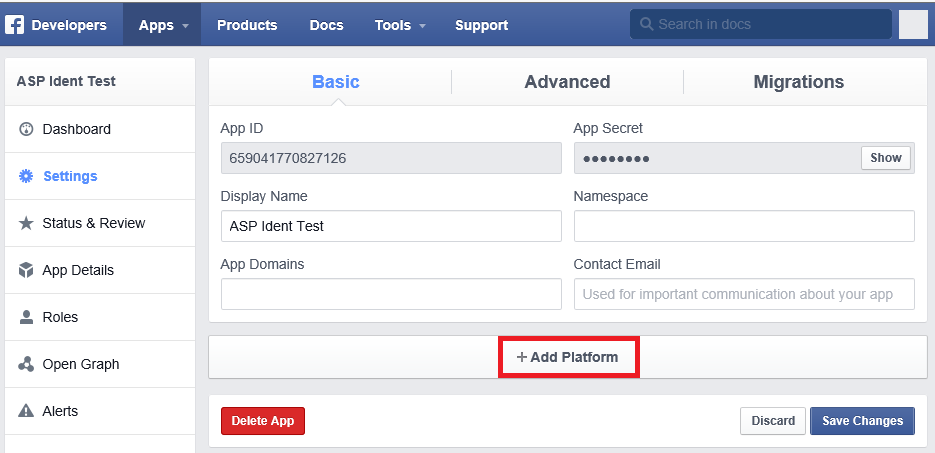
- Select Website from the platform choices.

- Make a note of your App ID and your App Secret so that you can add both into your MVC application later in this tutorial. Also, Add your Site URL (https://localhost:44300/) to test your MVC application. Also, add a Contact Email. Then, select Save Changes.
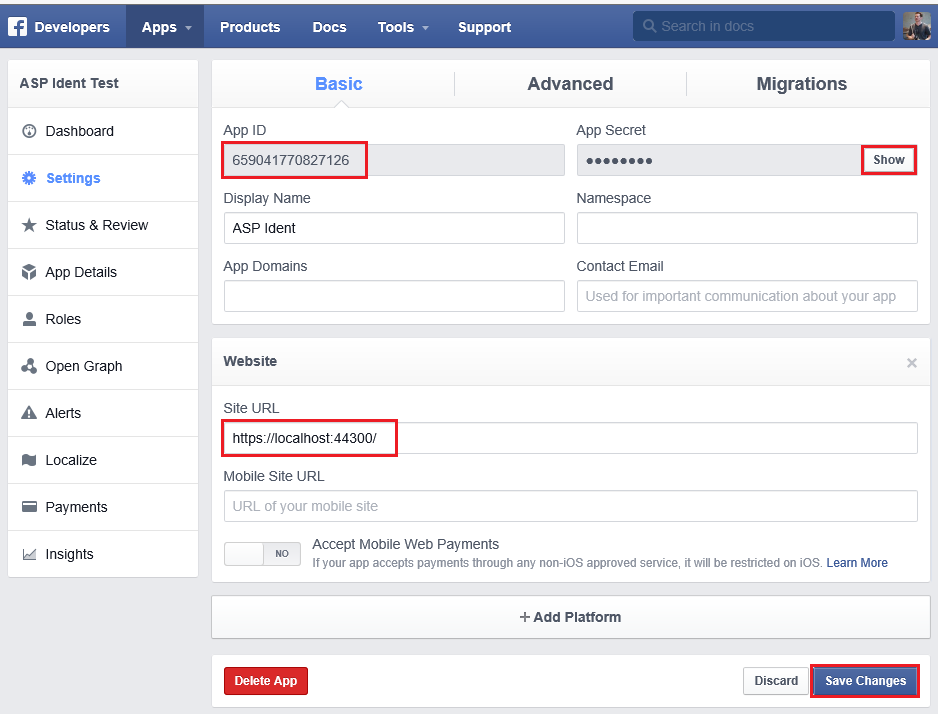 Note that you will only be able to authenticate using the email alias you have registered. Other users and test accounts will not be able to register. You can grant other Facebook accounts access to the application on the Facebook Developer Roles tab.
Note that you will only be able to authenticate using the email alias you have registered. Other users and test accounts will not be able to register. You can grant other Facebook accounts access to the application on the Facebook Developer Roles tab. In Visual Studio, open App_Start\Startup.Auth.cs.
Copy and paste the AppId and App Secret into the
UseFacebookAuthenticationmethod. The AppId and App Secret values shown below are samples and will not work.public void ConfigureAuth(IAppBuilder app)
{
// Configure the db context and user manager to use a single instance per request
app.CreatePerOwinContext(ApplicationDbContext.Create);
app.CreatePerOwinContext<ApplicationUserManager>(ApplicationUserManager.Create); // Enable the application to use a cookie to store information for the signed in user
// and to use a cookie to temporarily store information about a user logging in with a third party login provider
// Configure the sign in cookie
app.UseCookieAuthentication(new CookieAuthenticationOptions
{
AuthenticationType = DefaultAuthenticationTypes.ApplicationCookie,
LoginPath = new PathString("/Account/Login"),
Provider = new CookieAuthenticationProvider
{
OnValidateIdentity = SecurityStampValidator.OnValidateIdentity<ApplicationUserManager, ApplicationUser>(
validateInterval: TimeSpan.FromMinutes(30),
regenerateIdentity: (manager, user) => user.GenerateUserIdentityAsync(manager))
}
}); app.UseExternalSignInCookie(DefaultAuthenticationTypes.ExternalCookie); // Uncomment the following lines to enable logging in with third party login providers
//app.UseMicrosoftAccountAuthentication(
// clientId: "",
// clientSecret: ""); //app.UseTwitterAuthentication(
// consumerKey: "",
// consumerSecret: ""); app.UseFacebookAuthentication(
appId: "000000000000000",
appSecret: "000000000000000"); app.UseGoogleAuthentication(
clientId: "000000000000000.apps.googleusercontent.com",
clientSecret: "000000000000000");
}Click Save Changes.
Press CTRL+F5 to run the application.
Select Log in to display the Login page. Click Facebook under Use another service to log in.
Enter your Facebook credentials.
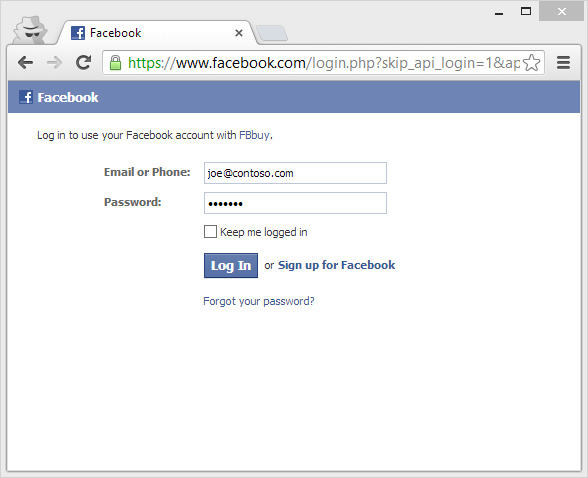
You will be prompted to grant permission for the application to access your public profile and friend list.
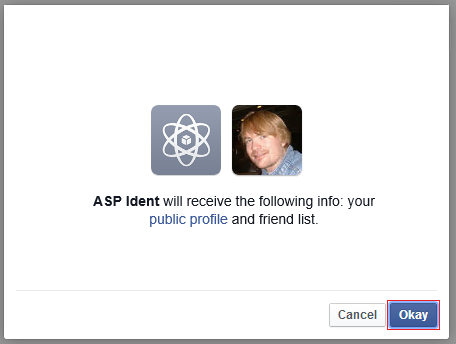
You are now logged in. You can now register this account with the application.

When you register, an entry is added to the Users table of the membership database.
Examine the Membership Data
In the View menu, click Server Explorer.
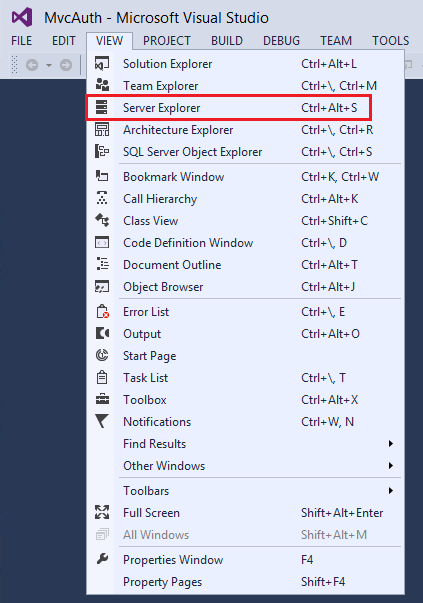
Expand DefaultConnection (MvcAuth), expand Tables, right click AspNetUsers and click Show Table Data.
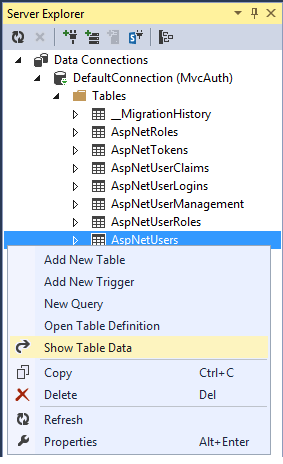

Adding Profile Data to the User Class
In this section you'll add birth date and home town to the user data during registration, as shown in the following image.
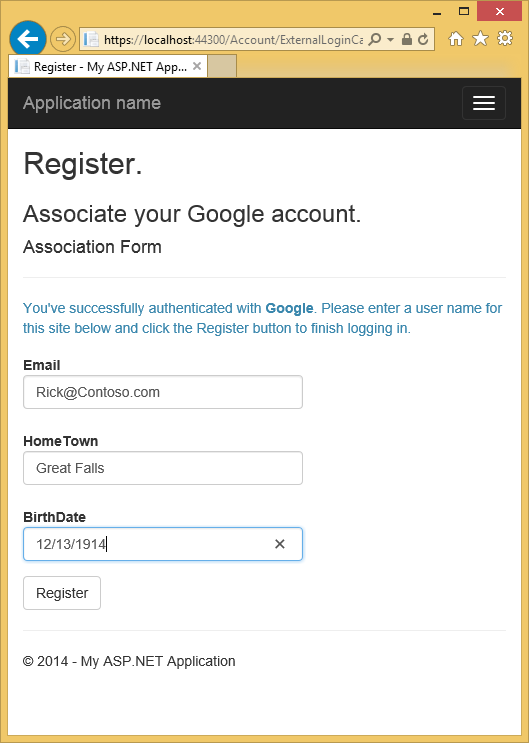
Open the Models\IdentityModels.cs file and add birth date and home town properties:
public class ApplicationUser : IdentityUser
{
public string HomeTown { get; set; }
public System.DateTime? BirthDate { get; set; }
public async Task<ClaimsIdentity> GenerateUserIdentityAsync(UserManager<ApplicationUser> manager)
{
// Note the authenticationType must match the one defined in CookieAuthenticationOptions.AuthenticationType
var userIdentity = await manager.CreateIdentityAsync(this, DefaultAuthenticationTypes.ApplicationCookie);
// Add custom user claims here
return userIdentity;
}
}
Open the Models\AccountViewModels.cs file and the set birth date and home town properties in ExternalLoginConfirmationViewModel.
public class ExternalLoginConfirmationViewModel
{
[Required]
[EmailAddress]
[Display(Name = "Email")]
public string Email { get; set; } public string HomeTown { get; set; }
public System.DateTime? BirthDate { get; set; }
}
Open the Controllers\AccountController.cs file and add code for birth date and home town in the ExternalLoginConfirmation action method as shown:
[HttpPost]
[AllowAnonymous]
[ValidateAntiForgeryToken]
public async Task<ActionResult> ExternalLoginConfirmation(ExternalLoginConfirmationViewModel model, string returnUrl)
{
if (User.Identity.IsAuthenticated)
{
return RedirectToAction("Manage");
} if (ModelState.IsValid)
{
// Get the information about the user from the external login provider
var info = await AuthenticationManager.GetExternalLoginInfoAsync();
if (info == null)
{
return View("ExternalLoginFailure");
}
var user = new ApplicationUser()
{
UserName = model.Email, Email = model.Email,
BirthDate = model.BirthDate,
HomeTown = model.HomeTown };
IdentityResult result = await UserManager.CreateAsync(user);
if (result.Succeeded)
{
result = await UserManager.AddLoginAsync(user.Id, info.Login);
if (result.Succeeded)
{
await SignInAsync(user, isPersistent: false); // For more information on how to enable account confirmation and password reset please visit http://go.microsoft.com/fwlink/?LinkID=320771
// Send an email with this link
// string code = await UserManager.GenerateEmailConfirmationTokenAsync(user.Id);
// var callbackUrl = Url.Action("ConfirmEmail", "Account", new { userId = user.Id, code = code }, protocol: Request.Url.Scheme);
// SendEmail(user.Email, callbackUrl, "Confirm your account", "Please confirm your account by clicking this link"); return RedirectToLocal(returnUrl);
}
}
AddErrors(result);
} ViewBag.ReturnUrl = returnUrl;
return View(model);
}
Add birth date and home town to the Views\Account\ExternalLoginConfirmation.cshtml file:
@model MvcAuth.Models.ExternalLoginConfirmationViewModel
@{
ViewBag.Title = "Register";
}
<h2>@ViewBag.Title.</h2>
<h3>Associate your @ViewBag.LoginProvider account.</h3> @using (Html.BeginForm("ExternalLoginConfirmation", "Account", new { ReturnUrl = ViewBag.ReturnUrl }, FormMethod.Post, new { @class = "form-horizontal", role = "form" }))
{
@Html.AntiForgeryToken() <h4>Association Form</h4>
<hr />
@Html.ValidationSummary(true, "", new { @class = "text-danger" })
<p class="text-info">
You've successfully authenticated with <strong>@ViewBag.LoginProvider</strong>.
Please enter a user name for this site below and click the Register button to finish
logging in.
</p>
<div class="form-group">
@Html.LabelFor(m => m.Email, new { @class = "col-md-2 control-label" })
<div class="col-md-10">
@Html.TextBoxFor(m => m.Email, new { @class = "form-control" })
@Html.ValidationMessageFor(m => m.Email, "", new { @class = "text-danger" })
</div>
</div>
<div class="form-group">
@Html.LabelFor(m => m.HomeTown, new { @class = "col-md-2 control-label" })
<div class="col-md-10">
@Html.TextBoxFor(m => m.HomeTown, new { @class = "form-control" })
@Html.ValidationMessageFor(m => m.HomeTown)
</div>
</div>
<div class="form-group">
@Html.LabelFor(m => m.BirthDate, new { @class = "col-md-2 control-label" })
<div class="col-md-10">
@Html.TextBoxFor(m => m.BirthDate, new { @class = "form-control" })
@Html.ValidationMessageFor(m => m.BirthDate)
</div>
</div>
<div class="form-group">
<div class="col-md-offset-2 col-md-10">
<input type="submit" class="btn btn-default" value="Register" />
</div>
</div>
} @section Scripts {
@Scripts.Render("~/bundles/jqueryval")
}
Delete the membership database so you can again register your Facebook account with your application and verify you can add the new birth date and home town profile information.
From Solution Explorer, click the Show All Files icon, then right click Add_Data\aspnet-MvcAuth-<dateStamp>.mdf and click Delete.
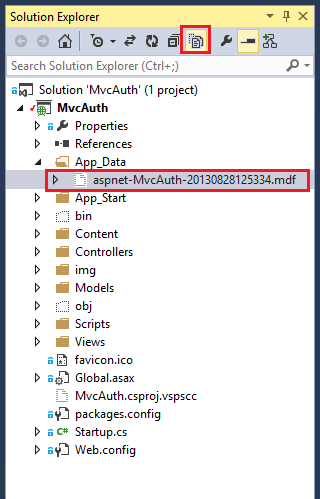
From the Tools menu, click NuGet Package Manger, then click Package Manager Console (PMC). Enter the following commands in the PMC.
- Enable-Migrations
- Add-Migration Init
- Update-Database
Run the application and use FaceBook and Google to log in and register some users.
Examine the Membership Data
In the View menu, click Server Explorer.

Right click AspNetUsers and click Show Table Data.

The HomeTown and BirthDate fields are shown below.
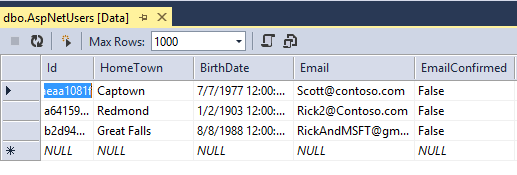
Logging off your App and Logging in With Another Account
If you log on to your app with Facebook, , and then log out and try to log in again with a different Facebook account (using the same browser), you will be immediately logged in to the previous Facebook account you used. In order to use another account, you need to navigate to Facebook and log out at Facebook. The same rule applies to any other 3rd party authentication provider. Alternatively, you can log in with another account by using a different browser.
Next Steps
See Introducing the Yahoo and LinkedIn OAuth security providers for OWIN by Jerrie Pelser for Yahoo and LinkedIn instructions. See Jerrie's Pretty social login buttons for ASP.NET MVC 5 to get enable social login buttons.
Follow my tutorial Create an ASP.NET MVC app with auth and SQL DB and deploy to Azure App Service, which continues this tutorial and shows the following:
- How to deploy your app to Azure.
- How to secure you app with roles.
- How to secure your app with the RequireHttps and Authorize filters.
- How to use the membership API to add users and roles.
Please leave feedback on how you liked this tutorial and what we could improve. You can also request new topics at Show Me How With Code. You can even ask for and vote on new features to be added to ASP.NET. For example, you can vote for a tool to create and manage users and roles.
For an good explanation of how ASP.NET External Authentication Services work, see Robert McMurray's External Authentication Services. Robert's article also goes into detail in enabling Microsoft and Twitter authentication. Tom Dykstra's excellent EF/MVC tutorial shows how to work with the Entity Framework.
This article was originally created on April 3, 2014
Author Information

Rick Anderson – Rick Anderson works as a programmer writer for Microsoft, focusing on ASP.NET MVC, Windows Azure and Entity Framework. You can follow him on twitter via @RickAndMSFT.
[转]Code! MVC 5 App with Facebook, Twitter, LinkedIn and Google OAuth2 Sign-on (C#)的更多相关文章
- Code! MVC 5 App with Facebook, Twitter, LinkedIn and Google OAuth2 Sign-on (C#)
http://www.asp.net/mvc/overview/security/create-an-aspnet-mvc-5-app-with-facebook-and-google-oauth2- ...
- MVC 5 App 通过 Facebook OAuth2 登陆(Sign-on)的问题
今天做了下MVC 5 App通过Google, Twitter, Linkedin 和 Facebook进行登录的例子, 算是对Asp.net Identity的一个入门,做的过程中发现了如下的问题, ...
- Sharing count on Facebook, Twitter, and LinkedIn
最近一段时间一直在研究有关Social Network的东西,这里有几个在当前国外主流社交网站上用来显示分享数量的API,记录一下,今后可能会用得着. Facebook Facebook将FQL(Fa ...
- 004.Create a web app with ASP.NET Core MVC using Visual Studio on Windows --【在 windows上用VS创建mvc web app】
Create a web app with ASP.NET Core MVC using Visual Studio on Windows 在 windows上用VS创建mvc web app 201 ...
- share.js一键分享到微博、QQ空间、QQ好友、微信、腾讯微博、豆瓣、Facebook、Twitter、Linkedin、Google+、点点等
官网上面 https://github.com/overtrue/share.js非常详细的介绍了share.js他的使用 使用方式有:第一:使用 npm npm install social-sha ...
- MVC Movie App
ylbtech- ASP.NET MVC:MVC Movie App 功能描述:MVC Movie App 2,TechnologyAndTheEnvironment(技术与环境) 操作系统: win ...
- Asp.Net Web Forms/MVC/Console App中使用Autofac
本来简单介绍了Autofac在Asp.Net Web Forms中的应用,后来又添加了mvc.控制台应用程序中使用Autofac,详情请看源码. ASP.NET Web Forms使用Autofac, ...
- ASP.NET API(MVC) 对APP接口(Json格式)接收数据与返回数据的统一管理
话不多说,直接进入主题. 需求:基于Http请求接收Json格式数据,返回Json格式的数据. 整理:对接收的数据与返回数据进行统一的封装整理,方便处理接收与返回数据,并对数据进行验证,通过C#的特性 ...
- FaceBook Twitter实习生简历求内推
写在博客里面吧. 有一个朋友,男,博士在读,研究方向为图像处理,计算机视觉相关. 想在在读期间有一些海外实习经历.不知道哪位博友,有相关的人脉,求内推啊.内推成功的话请吃大餐,哈哈!
随机推荐
- 解析大型.NET ERP系统 高质量.NET代码设计模式
1 缓存 Cache 系统中大量的用到缓存设计模式,对系统登入之后不变的数据进行缓存,不从数据库中直接读取.耗费一些内存,相比从SQL Server中再次读取数据要划算得多.缓存的基本设计模式参考下面 ...
- 我为NET狂~群福利:逆天书库
我为NET狂-官方群① 238575862 爱学习,爱研究,福利不断,技能直彪~~ 最近更新:2016-08-30,欢迎补充 暂缺PDF: │ SQL Server 2012 Analysis Ser ...
- SQL Server 监控系列(文章索引)
一.前言(Introduction) SQL Server监控在很多时候可以帮助我们了解数据库做了些什么,比如谁谁在什么时候修改了表结构,谁谁在删除了某个对象,当这些事情发生了,老板在后面追着说这是谁 ...
- 【.NET深呼吸】如何反序列化动态JSON
.net本身除了支持SOAP.XML.二进制等序列化和反序列化,后来也加入了对JSON的序列化的支持.然而,在实际开发中,常常会遇到结构不确定的JSON对象,这些对象可能是其他代码动态生成的,你事先无 ...
- JavaScript的闭包
1. 什么是闭包 通俗地讲,JavaScript 中每个的函数都是一个闭包,但通常意义上嵌套的函数更能够体现出闭包的特性,请看下面这个例子: var generateClosure = functio ...
- !+"\v1" 用来“判断浏览器类型”还是用来“IE判断版本”的问题!
这种写法是利用各浏览器对转义字符"\v"的理解不同来判断浏览器类型.在IE中,"\v"没有转义,得到的结果为"v".而在其他浏览器中&quo ...
- c 进程和系统调用
这一篇博客讲解进程和系统调用相关的知识 有这样一个场景,我需要输入一串文字,然后把我输入的文字加上一个本地的时间戳 保存在一个文件中,可以初步理解为一个备忘录也行 #include <stdio ...
- 完整记录一则Oracle 11.2.0.4单实例打PSU补丁的过程
本文记录了打PSU的全过程,意在体会数据库打PSU补丁的整个过程. 1.OPatch替换为最新版本2.数据库软件应用19121551补丁程序3.数据库应用补丁4.验证PSU补丁是否应用成功 1.OPa ...
- 【分布式】Zookeeper的服务器角色
一.前言 前一篇已经详细的讲解了Zookeeper的Leader选举过程,下面接着学习Zookeeper中服务器的各个角色及其细节. 二.服务器角色 2.1 Leader Leader服务器是Zook ...
- 一位同事对 Rafy 框架的一些建议及我的回复
下面是一位同事对当前的产品开发框架提出的一些建议,以及我的回复.我觉得一些问题提得有一定的代表性,在征得本人同意后,将本邮件发布在博客中. 同时,也非常希望对框架.产品有好的建议的小伙伴,都可以给我发 ...
